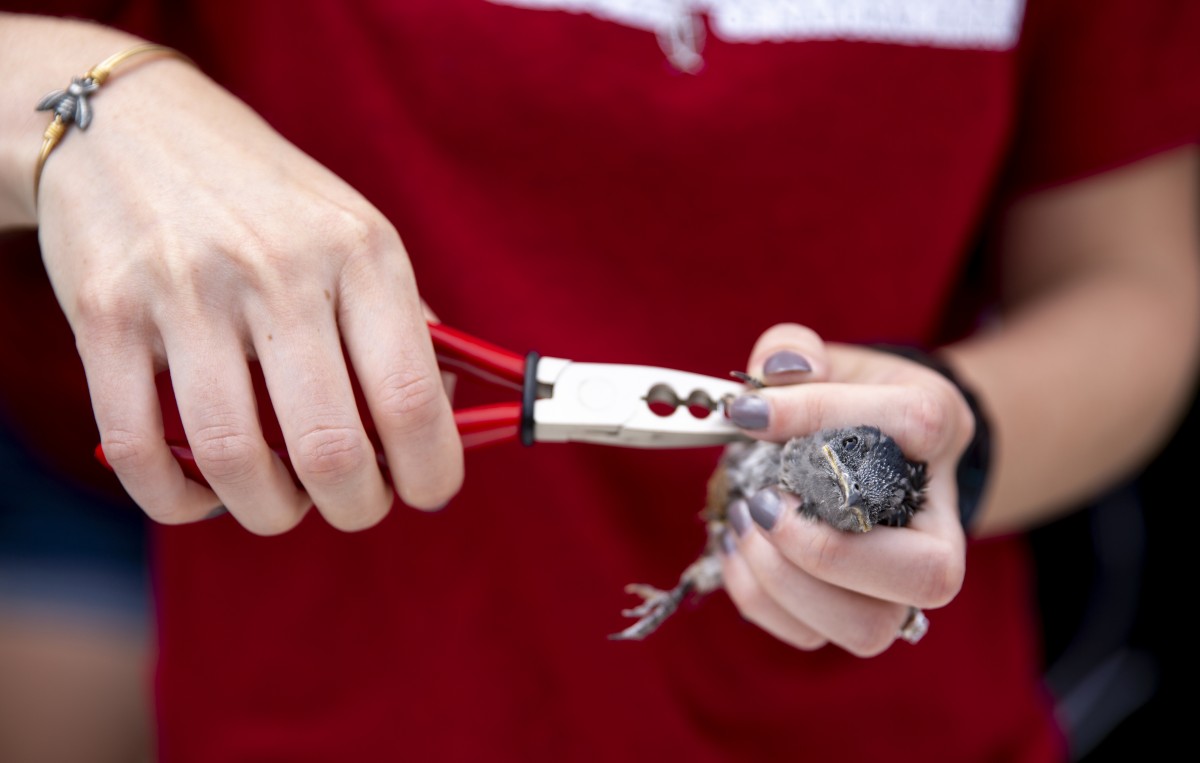As soon as Jack Gulvin turned a crank that lifted up a rack of nests in white, basketball-sized gourds, purple martins flocked to it, finding the nest that held their own little babies or eggs.
Their black and indigo bodies soared in the sky around the nests, which by now had been raised about 12 feet high. In one parent’s beak was a dead dragonfly it had just captured to feed its children.
“It looks like an Alfred Hitchcock movie,” said Gulvin on Monday as he stood, head tilted to the swarm of birds in the sky.
Gulvin has been taking care of the purple martin population at Chautauqua for 20 years, doing meticulous checks of each of the 102 compartments every five days from late May to the end of August.
At 4:15 p.m. Friday, July 5 near the lake between Miller Bell Tower and the Sports Club, Gulvin will facilitate a Purple Martin Chat, organized by the Bird, Tree & Garden Club. The chats take place at the same time and place every Friday through July 19, to teach Chautauquans about the birds.
During one of his checks on Monday, Gulvin filled out a detailed spreadsheet, neatly marking how many eggs or hatchlings, which he calls pinkies, are in each nest. He referred to a record of when the eggs were laid so he knows when they should hatch.
In one nest, the pinkies had hatched since the last time he checked them. With one hand, he took one of the hatchlings out of the nest and held it up to life-size reference pictures of the pinkies in his binder to figure out how old they were. They grow quite a bit every single day, so their ages were easy to tell: three days.
When mom and dad aren’t around to feed them, the hatchlings spend most of their time sleeping, smushed against each other like sardines in a can. They are pink and featherless, with two big round bulges at the top of their heads, where their eyes will open around nine days of age.
The warm weather this time of year has been perfect for purple martin hatching, Gulvin said. It has been a particularly good year for the babies.
“They look really fat and healthy,” he said.
In one of the nests, however, only one of the five eggs hatched. Gulvin tossed the four remaining eggs out into the surrounding brush and added some white pine needles to the nest to make sure the one surviving baby forms properly.
Gulvin speculated that the nest belonged to teenage purple martin parents who did not know how to properly build a nest or incubate the eggs.
Female purple martins lay one egg each day until her nest of eggs is complete. All of the eggs typically hatch within a day of each other.
Gulvin worked in resource management at the National Park Service, and retired 30 years ago at the age of 36. He now lives in Westfield, and keeps busy checking on the purple martins at Chautauqua Institution, as well as some purple martin nests and a dozen bluebird boxes in Westfield.
Gulvin said he did not know much about purple martins when he took over caring for them 20 years ago. He quickly learned about the species and how to care for them with help from the Purple Martin Conservation Association, which is based in Erie, Pennsylvania.
There is one cluster of nests at the Chautauqua Golf Club, one near the shuffleboard courts and three on the shore near the Sports Club. Some of the nests are housed in what look like birdhouse apartment buildings that have 14 compartments each and are made by a local Amish man. Some are in round gourds, either natural or plastic, that hang from racks hoisted onto a pole.
The golf course and lake front provide a good environment for the birds, who do best in wide-open spaces devoid of trees, to avoid predators like hawks.
“On the East Coast, (the birds) are completely dependent on humans to provide them housing,” Gulvin said.
Gulvin designed and built some compartments that look like little metal buckets and are inspired by woodpecker cavities. These compartments hang from the bottom of the wooden structures.
“There’s something about purple martins that make you inventive,” he said.
Every winter, Gulvin takes down the natural gourds. They get scraped and sanded, repainted and primed to get them ready them for the next season.
The purple martins have clearly taken a hold on Gulvin, who dedicates much of his time to taking care of them. When he dies, he said he will leave his entire estate to the Purple Martin Conservation Association, since he does not have a spouse or children.
When he finished checking one batch of compartments, Gulvin stepped back and relished in watching the parent purple martins flock in to feed their children. He said his best turnout was about five years ago, when he helped to fledge 423 martins from the Institution.
“I don’t get paid in anything but personal satisfaction with raising all of these birds,” he said.
And then he went off to check the last cluster of nests.






